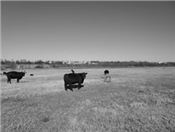|
‘Take Half, Leave Half’: How To Avoid Overgrazing Pastureland

Unfortunately, overgrazed pasture is a common sight in much of Arkansas.
Division of Agriculture photo
FAYETTEVILLE, ARK.
Anyone who’s driven the highways of the western half of Arkansas has seen it: overgrazed pastures, nearly denuded and almost bare of plant ground cover, save for some tall, brush-like weeds in one corner of the pasture or another.
“Unfortunately, overgrazed pastures are a quite frequent sight in the fall,” Dirk Philipp, associate professor of animal science for the University of Arkansas System Division of Agriculture, said.
“There’s usually a host of non-desirable species such as broomsedge, foxtail and even pigweed showing up in overgrazed pastures,” he said.
But the aesthetic effects of overgrazing are secondary to the actual ecological impacts that may be taking place, Philipp said.
“It’s not visible by the human eye, but soil compaction may be an issue if stocking rates have been kept high for years,” he said.
While prolonged overstocking does present a problem, Philipp said, unrealistic expectations on the part of the landowner may be at the root of the issue.
“Producers naturally seek to maximize their return – and there’s nothing wrong with that,” he said. “However, stocking rates are often too high for sustainably producing forages and maintaining pasture health and productivity long term. Since returns are low in cow/calf operations, there’s little room for expensive inputs, either.”
To maintain high stocking rates, landowners should increase their inputs accordingly, Philipp said. Fertilizers, liming, reseeding and weed control are all recurring needs for healthy grazing pastures.
Many landowners in Arkansas keep as many as two to three cow/calf pairs per acre, Philipp said. While some areas may support this, the rate may actually be too high for many pastures in the state.
As a result of high stocking rates, Philipp said, forage can be in short supply during the colder parts of the year.
“Producers end up relying too much on hay feeding,” he said. “Hay may be relatively affordable when bought from a supplier, but feeding for prolonged periods of time has its own financial challenges.”
Hay feeding areas are prone to soil compaction and soil nutrient imbalances, Philipp said. Large amounts of seeds, either from other forages or weeds, are carried in, which can wreak havoc with your original pasture plan. Constant additional grazing in pastures can reduce leaf area and root growth to such an extent that a recovery may not be possible during the following spring.
To avoid overgrazing, Philipp offers some general guidelines for pasture managers.
“Be realistic with overall stocking rates,” he said. “Make sure that whenever you graze pastures, you can afford to ‘take half, leave half’ of the standing forage.”
If a producer is forced to graze lower than six inches to make “the paddock last a bit longer,” the overall stocking rate may be too high.
“Ideally, you need to leave room every year for stockpiling your fescue, overseeding dormant warm season forages with winter annuals and possibly plant summer annuals,” Philipp said. “All this requires that you have a forage and pasture management plan, and that you actually have enough ‘buffer’ in your operation so that you can move your animals to other pastures and make room for the necessary pasture upkeep and maintenance.” ∆
|
|